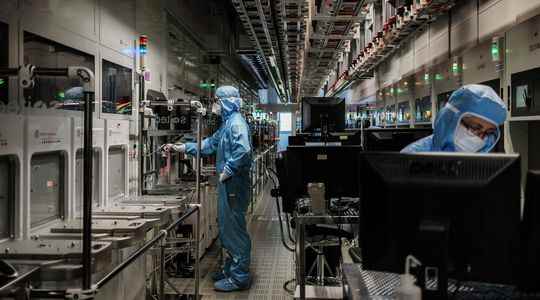Nobody knows of its existence, and yet a host of companies depend on it indirectly. Purified neon has been added to the long list of strategic resources whose supply is jeopardized by the war in Ukraine. The neon market only weighs a few hundred million euros, but it is a key link in the manufacture of semiconductors. It is used to power the lasers that etch the delicate circuitry of electronic chips, now found everywhere, from smartphones to computers, cars and industrial robots.
The problem ? More than 50% of the highly purified neon used in the world comes from a single country: Ukraine. This specialization is not new. It was set up during the Soviet era. Betting that neon could be used to manufacture certain military equipment, the USSR had chosen to equip many of its steelworks with air separation units. These modules separate oxygen and nitrogen (consumed by the plant) from other gases contained in low doses in the air, such as neon. Since then, the latter was sent to Ukraine where it was refined, in order to reach a very high degree of purity (99.999%).
Manufacturers have a few weeks of stock
The war that Russia has declared on Ukraine obviously upsets the situation. While some citizens join the army to defend their country, and others desperately try to protect themselves or flee the incessant bombardments, it is impossible for businesses in the country to operate. Strategic neon producers, such as Cryoin in Odessa, had to stop their chain.
Certainly, their customers are slightly better prepared for this crisis than in 2014, when the invasion of Crimea by Russia had already created great tensions in the neon market. The manufacturers who buy this gas have in particular reserves enabling them to operate normally for the time being. “However, the shelf life of the materials used in semiconductors is limited, in order to guarantee their reliability”, explain analysts from Techcet, a consulting firm specializing in the sector. The storage of this gas has, on the other hand, a cost (all the more so in this period of shortage of containers). Manufacturers therefore have limited reserves. “Smartphone manufacturers have enough to hold out for the month of March, or even April, says Neil Mawston, executive director of Strategy Analytics. But, by May, they will have to find alternative suppliers.”
The problem is that the options are few. China refines neon. However, increasing the volumes produced does not happen overnight. “And Chinese companies will probably serve their local customers before selling to others,” said CCS Insight analyst Marina Koytcheva. The United States, which also lists a few producers, will certainly do the same.
Chip shortages block manufacturers
The option to open new sites would take even longer. “Everything used to manufacture semiconductors must meet very strict specifications in order to prevent the risk of chip malfunctions”, confirm Techcet analysts. According to the specialized firm, the process of certifying a new neon supplier would take “six to nine months in the best case”, and could cost “millions of dollars”. If Ukrainian industries and their logistical hubs (notably ports) continue to be blocked or damaged, the impact will therefore soon be felt on the semiconductor industry as well.
This is all the more problematic as this sector is emerging from two dark years. Waves of Covid contamination have prevented semiconductor factories from operating normally. Added to this is telework, which has boosted an already growing demand for connected equipment. Result, shortages that have had serious consequences on the economy. Tech manufacturers have had to revise their production targets downwards (like Apple, which made 11 million fewer iPhones than expected in 2021). And the automotive sector has been severely affected. Many manufacturers (Renault, Stellantis, General Motors, etc.) have therefore had to temporarily close their factories.
Of course, it is not easy to diversify a manufacturing chain as extraordinarily complex as that of semiconductors. “We are talking about a process of several hundred steps, carried out in different places around the globe,” argues Julian Ringhof, specialist in geopolitics of technologies at the European Council on International Relations (ECFR). A clever circuit between specialized world poles, which has had the merit of always improving these products, and reducing their cost.
But it also weakens a chain that is strategic in our contemporary economies. The Old Continent has begun to realize it. Last February, the Brussels Commission proposed a 42 billion euro investment plan to rebuild a European semiconductor manufacturing industry worthy of the name. While it occupied 40% of this market in the 1990s, it is now capped at a meager 10%. On this occasion, Thierry Breton, Commissioner for the Internal Market, had also warned of the risks of too much dependence on other countries (particularly in Asia) for such a sensitive product: “If Taiwan was no longer able to export, in three weeks all the factories in the world would stop.” No one imagined then that supplies from Ukraine could also run out.
